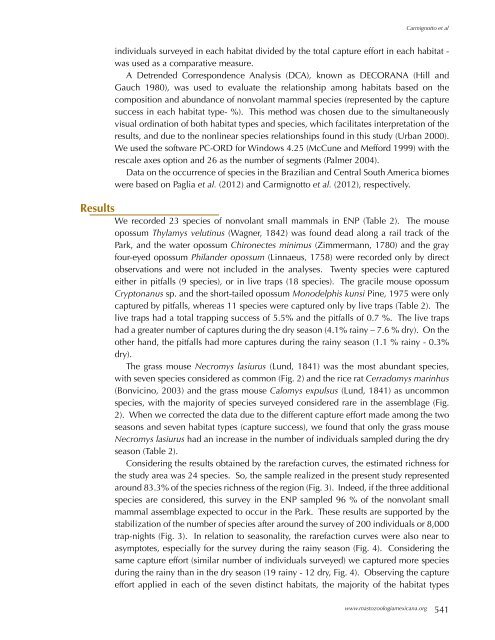therya-5_2
therya-5_2
therya-5_2
You also want an ePaper? Increase the reach of your titles
YUMPU automatically turns print PDFs into web optimized ePapers that Google loves.
Carmignotto et al<br />
Results<br />
individuals surveyed in each habitat divided by the total capture effort in each habitat -<br />
was used as a comparative measure.<br />
A Detrended Correspondence Analysis (DCA), known as DECORANA (Hill and<br />
Gauch 1980), was used to evaluate the relationship among habitats based on the<br />
composition and abundance of nonvolant mammal species (represented by the capture<br />
success in each habitat type- %). This method was chosen due to the simultaneously<br />
visual ordination of both habitat types and species, which facilitates interpretation of the<br />
results, and due to the nonlinear species relationships found in this study (Urban 2000).<br />
We used the software PC-ORD for Windows 4.25 (McCune and Mefford 1999) with the<br />
rescale axes option and 26 as the number of segments (Palmer 2004).<br />
Data on the occurrence of species in the Brazilian and Central South America biomes<br />
were based on Paglia et al. (2012) and Carmignotto et al. (2012), respectively.<br />
We recorded 23 species of nonvolant small mammals in ENP (Table 2). The mouse<br />
opossum Thylamys velutinus (Wagner, 1842) was found dead along a rail track of the<br />
Park, and the water opossum Chironectes minimus (Zimmermann, 1780) and the gray<br />
four-eyed opossum Philander opossum (Linnaeus, 1758) were recorded only by direct<br />
observations and were not included in the analyses. Twenty species were captured<br />
either in pitfalls (9 species), or in live traps (18 species). The gracile mouse opossum<br />
Cryptonanus sp. and the short-tailed opossum Monodelphis kunsi Pine, 1975 were only<br />
captured by pitfalls, whereas 11 species were captured only by live traps (Table 2). The<br />
live traps had a total trapping success of 5.5% and the pitfalls of 0.7 %. The live traps<br />
had a greater number of captures during the dry season (4.1% rainy – 7.6 % dry). On the<br />
other hand, the pitfalls had more captures during the rainy season (1.1 % rainy - 0.3%<br />
dry).<br />
The grass mouse Necromys lasiurus (Lund, 1841) was the most abundant species,<br />
with seven species considered as common (Fig. 2) and the rice rat Cerradomys marinhus<br />
(Bonvicino, 2003) and the grass mouse Calomys expulsus (Lund, 1841) as uncommon<br />
species, with the majority of species surveyed considered rare in the assemblage (Fig.<br />
2). When we corrected the data due to the different capture effort made among the two<br />
seasons and seven habitat types (capture success), we found that only the grass mouse<br />
Necromys lasiurus had an increase in the number of individuals sampled during the dry<br />
season (Table 2).<br />
Considering the results obtained by the rarefaction curves, the estimated richness for<br />
the study area was 24 species. So, the sample realized in the present study represented<br />
around 83.3% of the species richness of the region (Fig. 3). Indeed, if the three additional<br />
species are considered, this survey in the ENP sampled 96 % of the nonvolant small<br />
mammal assemblage expected to occur in the Park. These results are supported by the<br />
stabilization of the number of species after around the survey of 200 individuals or 8,000<br />
trap-nights (Fig. 3). In relation to seasonality, the rarefaction curves were also near to<br />
asymptotes, especially for the survey during the rainy season (Fig. 4). Considering the<br />
same capture effort (similar number of individuals surveyed) we captured more species<br />
during the rainy than in the dry season (19 rainy - 12 dry, Fig. 4). Observing the capture<br />
effort applied in each of the seven distinct habitats, the majority of the habitat types<br />
www.mastozoologiamexicana.org<br />
541



